Donated Treasures at the National Museum of Qatar
The National Museum of Qatar’s collection includes meaningful gifts that celebrate Qatari life, heritage, and personal stories from our community.

Dugong rib fossils from the Miocene period, discovered in the Dammam Formation, Qatar. c.20 million years old.
These three dugong bone fossils come from an ancient species of marine mammal that still survives in the waters around Qatar today. These bones are vertebral bones, meaning they were from the ribs of the dugong, also known as a seacow. Geologists estimate that these bones are around 20 million years old.
Geologists discovered these fossils in the Dammam Formation, a layer of sedimentary rock in Southwest Qatar, which formed during the Miocene period. At the beginning of this period, what is now known as Qatar was largely underwater.
Dugongs are gentle, slow-moving animals related to manatees and are part of the Sirenia order. They graze on seagrass in shallow coastal waters. These fossils are evidence of how dugongs have long played a role in the natural and cultural history of the Gulf.
Asian Games Torch
Doha, Qatar, hosted the 15th Asian Games in 2006. This was the torch used for the torch relay. The horns of the Arabian Oryx, Qatar's national animal, inspired the design, while the maroon and white colours reflect the colours of the Qatar flag.
The torch relay covered over 50,000 kilometres and visited 15 countries in Asia, making it the longest relay in the history of the Asian Games at the time. More than 3000 athletes carried the torch during its journey. H.E. Mohammed bin Hamad bin Khalifa Al Thani lit the astrolabe-shaped cauldron in the Khalifa International Stadium at the opening ceremony on 1 December 2006.
The torch is a testament to the range and quality of sporting events held by Qatar since the 1970s.

The torch used in the 2006 Asian Games in Doha, Qatar, features a design inspired by the Arabian Oryx and the maroon and white colours of the Qatari flag.
Al-Murashaha (Traditional Horse Saddle Set)

Traditional murashaha horse saddle set with sadu weaving, tassels, and metal stirrups, including bridle and decorative tack.
The murashaha is a traditional horse saddle set made of wool and leather, lined with felt and decorated in the sadu weaving style, with colourful tassels adorning its edges. It covers the horse’s back and sides, secured with straps and fitted with metal stirrups.
The rasan (lead rope), rashmah (braided headpiece), lijam (bridle), sadriah (breast collar), batan (girth strap), and ribaat (tie cord) would all attach and help secure the saddle and control the horse. They also add an aesthetic value that enhances the horse’s majestic appearance during parades and celebrations.
Medallion
Medallion struck for the opening of the Qatar National Museum on June 23, 1975, by His Highness Shaikh Khalifa bin Hamad al Thani, Amir of the State of Qatar, 1975. On the obverse is a bust facing left of the Amir, and on the reverse, a motif of the museum building framed in a rectangular hour-glass-shaped line with Arabic writing around 2/3 of the exterior edge of the medallion.
Thomas Fattorini of Regent Street, Birmingham, England, manufactured the medallion and its box. The rectangular-shaped box has a hinged lid.
Inside the box is a black velvet-covered cardboard with a circular cut-out to hold the coin, which rests on a black velvet-covered cushion. A white silk ribbon is attached and used to lift the Medallion from its support. White moulded plastic trays line the lid and body of the box. Brass trim edges the lid, and a layer of satin fabric covers the white plastic tray. Within the box, there is a piece of paper with reddish ink in English describing the event.

1975 medallion commemorating the Qatar National Museum opening, featuring Amir Khalifa bin Hamad.
Batoola
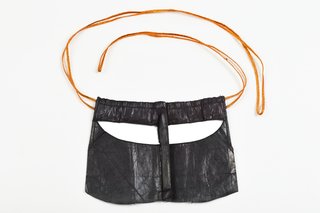
Batoola, Indigo-dyed cotton face mask with wooden nose stick and metallic cord loops.
Single-layered cotton face mask with heavy metallic colouring (indigo dye) giving an iridescent sheen to the front surface. There is a central nose ridge creating a channel for a flat wooden stick. The stick is a little shorter than the height of the mask. The side seams and top edge are turned back and stitched, as are the edges of the eyeholes. The bottom edge is raw cut and is fraying.
The top-stitched edge is slightly gathered but not stretchy.
On the reverse, the section above the eyeholes has a stitched lining of presumably black cotton. The remainder of the reverse has an adhered paper lining, similar to a wide masking tape, which overlaps horizontally in the centre. Blue dye has partially stained the lining.
At both top corners, a long hoop of flat metallic cord is stitched between the front fabric and lining. The right cord is much longer than the left cord.
See More Donated Treasures
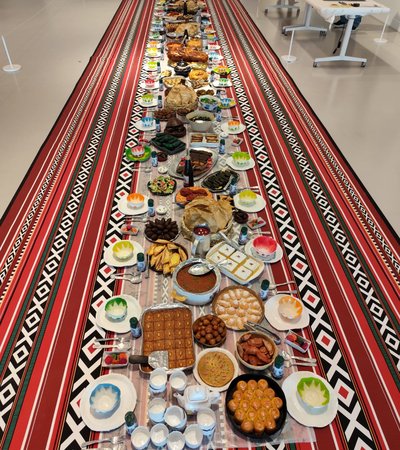
Donated Treasures at Mathaf
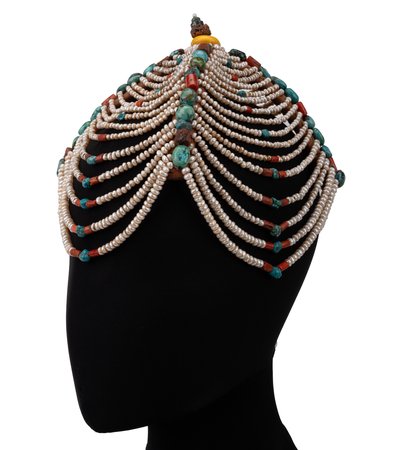
Donated Treasures at the National Collection of Qatar
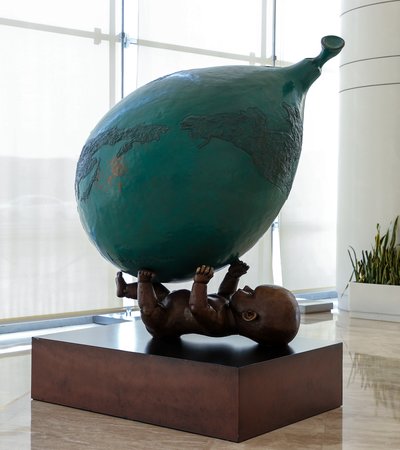
Donated Treasures at Public Art
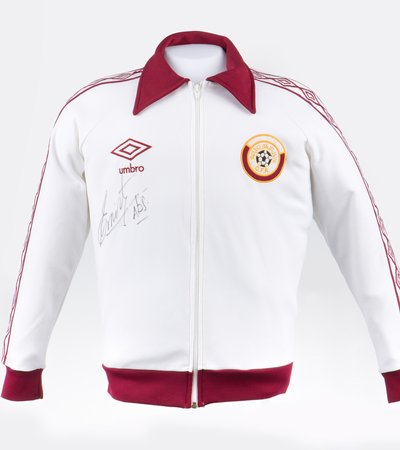
Donated Treasures at 3-2-1 Qatar Olympic and Sports Museum